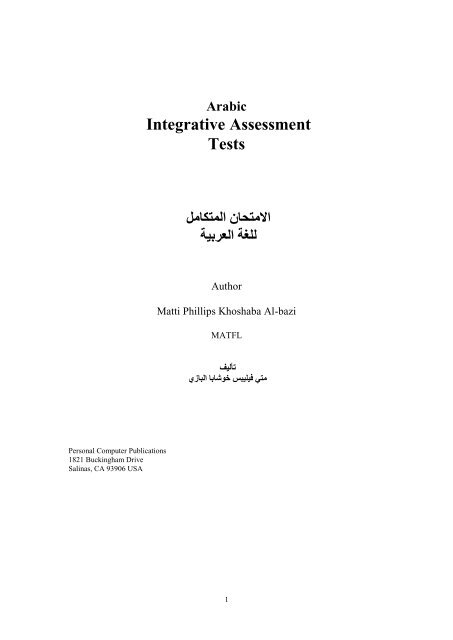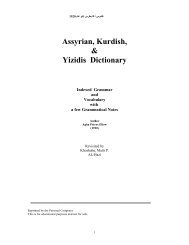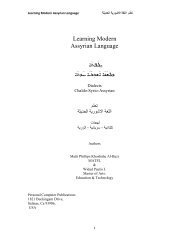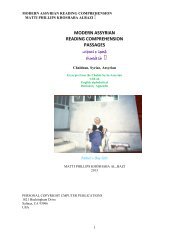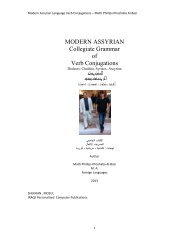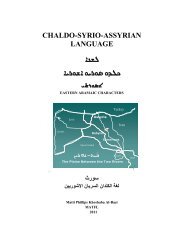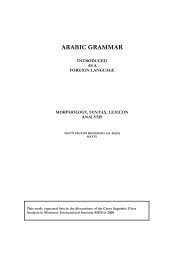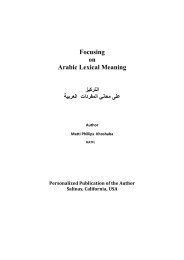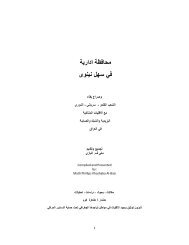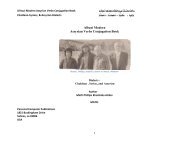Integrative Arabic Assessment Test
Integrative Arabic Assessment Test
Integrative Arabic Assessment Test
You also want an ePaper? Increase the reach of your titles
YUMPU automatically turns print PDFs into web optimized ePapers that Google loves.
<strong>Arabic</strong><br />
<strong>Integrative</strong> <strong>Assessment</strong><br />
<strong>Test</strong>s<br />
االمتحان المتكامل<br />
للغة العربية<br />
Author<br />
Matti Phillips Khoshaba Al-bazi<br />
MATFL<br />
تأليف<br />
متي فيليبس خوشابا البازي<br />
Personal Computer Publications<br />
1821 Buckingham Drive<br />
Salinas, CA 93906 USA<br />
1
<strong>Integrative</strong> <strong>Arabic</strong> <strong>Test</strong> (IAT)<br />
C-<strong>Test</strong> (rule of 2), multiple-choice discrete-point method, and dictocomps<br />
Matti Phillips Khoshaba Al-bazi<br />
This is an integrative <strong>Arabic</strong> test (IAT) that is<br />
designed to test the overall ability of learners and students using<br />
<strong>Arabic</strong> language – as foreign learners or <strong>Arabic</strong> natives - for their<br />
own purposes in politics, economy, health, social, culture<br />
and<br />
others. This IAT can also be used to measure the students’ progress<br />
and achievement during <strong>Arabic</strong> courses as a foreign language in the<br />
advanced levels.<br />
The Purpose of the test:<br />
The purpose of this study is also to check out the possibility of applying C-<strong>Test</strong><br />
(rule 2) as an easy and simple test to construct for the students while taking classes in four skills of<br />
<strong>Arabic</strong>: reading, writing, listening and speaking. It may also assess the overall <strong>Arabic</strong> ability of the<br />
students as foreign learners (Braley, C. 1984). This module, I can say, is accurate and effective in<br />
assessing the <strong>Arabic</strong> natives’ ability in all skills for proficiency purposes as reading, writing, listening<br />
and speaking all in one integrative test such as IAT.<br />
The investigation might go deeper to see if this test discriminates between the<br />
groups of learners according to the time they have spent experiencing this language, and also see if it<br />
discriminates the good learners from the bad ones within the group itself. This investigation would<br />
include the construct validity of the test as a whole, the discriminative index (ID) of Multiple-Choice<br />
(MC) items, the item facility means (IF), the standard deviation of the students’ scores (SD), and the<br />
correlation coefficient (rxy) between its three or four sections as subtests. All these statistics might help<br />
to find if this test has the validity and the reliability to be applied to assessing the <strong>Arabic</strong> language<br />
proficiency. <strong>Arabic</strong> schools-whether in the Arab States’ Universities or in the Western Countries<br />
which are concerned about teaching this language -might one day adopt these kinds of tests for the final<br />
assessment of their students’ proficiency level(s) in listening and reading or translation purposes. They<br />
2
might also use this test for assessing their students’ language progress and /or achievements during their<br />
intensive <strong>Arabic</strong> courses as diagnostic assessments of their progress.<br />
In sum, the goals of the study are: (1) How reliable the C-<strong>Test</strong> would be to test the overall ability of<br />
the <strong>Arabic</strong> Foreign learners? (2) How would the two variables of C-<strong>Test</strong>s correlate with the other<br />
sections of the test?<br />
(3) Would it discriminate between the low and the advanced groups or<br />
individuals?<br />
Operationalization of the definitions:<br />
The notion that the test is integrative comes from the fact that IAT uses multifaceted methods<br />
to test the general knowledge of the examinees’ language through authentic contextual language<br />
material of various lengths taken from the different <strong>Arabic</strong> magazines or newspapers from the Internet.<br />
The C-test (rule of 2) has two variables since the deletions in each passage are different<br />
(Clearly, C. 1988). In question 1, the missing letters are at the beginning of the word known as (RH)<br />
whereas in question 2 the missing letters are at the end of the word as (LH), on the theory that (RH C-<br />
<strong>Test</strong>) tests micro (intra-sentential relations of the words of the text) and macro (the inter-sentential<br />
relations of the sentences throughout the whole text) elements and issues of the target language.<br />
On the other hand, it is suggested that (LH C-<strong>Test</strong>) also tests the micro level elements of the<br />
language since the macro ones take the form of the free morphemes when it happens that they are at the<br />
end of the word. The pragmatic elements to be tested, according to my understanding, are the delicate<br />
issues related to the connotations and/or subliminal meanings related to the missing parts of the texts.<br />
These inferential and/or abstract cues are often detected through the general hidden voice between the<br />
lines of the text rather than the words in isolation. A few indications of conversational and dialogic or<br />
rhetoric cues scattered here and there all over the text might help the good learners to use them as clues<br />
for understanding the contents of the texts for overall messages that flow within the sentences and<br />
paragraphs of the tests . Bachman described this pragmatic part of the language as extra-textual<br />
information of sociolinguistic element and/or discourse of the target language (Bachman, 1995).<br />
Understanding these pragmatic issues requires a lot of background information to answer those kinds of<br />
questions.<br />
To help the examinees, I left two sentences at the beginning and the end of the C-<strong>Test</strong> passages<br />
un-mutilated and intact to help the examinees discern the theme of the passages. These two intact<br />
3
sentences stimulate the examinees to guess generally what the theme is about and accordingly try hard<br />
to fill the gaps (Clearly, C. 1988). With regard to the students’ efforts when taking C-<strong>Test</strong>s as<br />
contextualized language material of all language elements, C-<strong>Test</strong>s demand a lot of work from the<br />
Examinees. Braley (1984) described it as in the following:<br />
The test subject pieces the text together, using all he or she knows of the language, and<br />
about the language, and about the real world, and moves backwards and forwards inside<br />
the text, after revising earlier guesses as other parts of the text are restored.<br />
his I<br />
test is integrative because it demands different responses from the examinees<br />
according to the methods of the test sections. C-<strong>Test</strong>, for example, demands from the testees produce<br />
the missing parts of the text by reading it as a whole. Multiple-choice questions demand from them that<br />
they read the <strong>Arabic</strong> short-text as a referent material and then select the best answer from among the<br />
four options given in English for each item. Dictocomps demand from the examinees to decode and<br />
then encode information of the texts to which they listened by giving them adequate time to write the<br />
answers (Bailey, 1998). Bachman explains this interaction between the test and the examinees as<br />
modes, channels, stimulus of the tests, and the responses of the examinees (Bachman, L. 1995).<br />
This test is also authentic in that all the material exposed to the students is articles or shorttexts<br />
taken from the <strong>Arabic</strong> newspapers, magazines, and other mass media. No alterations,<br />
modifications, changes, or amendments are made to the originals.<br />
Selection of the material of the test and the allocation of the time:<br />
Being not sure of the results of applying C- est principle to test students’ ability in rabic<br />
language as non-natives, I came to consult my colleagues to check for validity the lexical words,<br />
linguistic and discourse structures, and the lengths of the texts (Farhady, H. 1996). Finishing designing<br />
the C-<strong>Test</strong> passages, the multiple-choice questions, I let the test be subject to the scrutiny of my<br />
colleagues who piloted it as natives (Hughes, 1989). We the three ( 2 others and me) agreed that the<br />
level of the texts would match the students’. Meanwhile, one of the colleagues told me, and s/he was<br />
right, that the RH C-<strong>Test</strong>s would influence the results of the students since mutilations have had<br />
damaged the “roots’ of the words, thinking that is tough for the non-natives -or natives who have little<br />
schooling about <strong>Arabic</strong>- to work it out (Cohen, A. 1984).<br />
4
Restrictions on the time and length of the response are taken into consideration (Bachman, L.<br />
1995). We, therefore, discussed together how long the test was going to be, and we agreed upon that 45<br />
minutes would be enough for the students to answer the two C-<strong>Test</strong> passages and the 10 multiple-choice<br />
questions of short reading-texts in one teaching hour.<br />
Dictocomps are taped passages read twice for the examinees. They are motivating in that the<br />
instructions are read in English, and the two passages are read twice in the normal speed of an Arab<br />
native speaker. Students are given 5 minutes for each passage to recall and write down the content in<br />
English since they are not trained in using the target language to answer their essay questions.<br />
20 minutes for the dictocomps questions were decided to be enough if given at the lab hour.<br />
Both groups of students in 2 different places followed the same instructions and procedures to<br />
carry out the test in two different times. Students were not informed about the test until the last minute<br />
before taking it. It is worthy here to say that both places were not familiar with the C-<strong>Test</strong> format and<br />
the dictocomp format of recalling the information of the passages to write them down in English.<br />
Another norm is the reliability of the test in connection to its validity (Bachman, L.1995).<br />
Subjects, methods of teaching, students’ response, and scoring:<br />
The test is administered in one of the Universities to two groups from different sections A and C.<br />
Group A is of 15 students, and they are in their almost advanced level. On the other hand, Group C is<br />
of 20 students, and they are more advanced a bit than the other group.. Therefore, Group C are 6 weeks<br />
ahead of Group A in the course. The knowledge and the background of the students in Group C must<br />
be richer since their experience and ‘maturational linguistic development’ with the target language (<br />
Chappelle, C. & Abraham, R. 1990,) <strong>Arabic</strong> is longer, taking into consideration the total class hours of<br />
the input that they were exposed to during these five weeks of the course.<br />
Approaches of teaching are a little bit different between the two Groups. In Group C, teachers<br />
are free to teach grammar or grammar related to lexical words with negotiation of meanings whenever<br />
the students and the instructors have the opportunity to do so. On the other hand, Group A instructors<br />
had already introduced grammar rules and explanations of grammar at an early stage and for eight<br />
months. They are not willing now to do so. They believe that their students need to be taught globally<br />
by exposing them to more authentic language passages. Wh-questions (EEs) are final language<br />
objectives (FLOs) to test their students’ ability of comprehension in reading and listening every day,<br />
5
saying that their students learn the way they have been taught during the classes. All the authentic<br />
material passages are presented in a way similar to the ways that they are going to be tested, which is all<br />
skimming and then scanning. Teachers in Group C isolate classes of listening for<br />
listening, reading for reading, and speaking for speaking. The gender factor is not taken into<br />
consideration for both groups in this study.<br />
Students in C-<strong>Test</strong>s would fill in the blanks with the missing letters of the words using the<br />
same testing sheet. In Multiple-choice questions, students would write the letter of the correct answer<br />
in the blank of the stem using the same testing sheet. In regard to the dictocomps, a blank sheet of<br />
paper is attached to the testing booklet so that the students can use both sides of it for writing their<br />
answers and notes. By using the same testing booklets, students will save money, effort, and time for<br />
the teaching administration.<br />
The validity of the test:<br />
IA test has facial validity to test language in contextual material by C-<strong>Test</strong>s, Multiple-choice<br />
questions, and the dictocomp passages. Students were satisfied that this material and the various<br />
methods might really test their ability and knowledge of the <strong>Arabic</strong> language (Bachman,1995).<br />
In Table 1, the mean, mode, and median of the two classes show that the results are normal. The<br />
difference in means is nearly 2 points, an indication that the validity has strong relation with the<br />
reliability of the test since the test was statistically able to evaluate Class C as being more advanced<br />
than A by 6 weeks (Hughes, 1995) without the knowledge of the researcher. The median and mode are<br />
accordingly higher too. The range of the scores in group C shows a huge disparity between the<br />
subjects of the group (27-79).<br />
he standard deviation is 13.50. It is high because the students’ level is<br />
less homogenous and/or the discriminability of the items is high too. The other reason might be that the<br />
grades of a couple of students who got zero effected statistically the distribution of the scores<br />
(Brown, 1988). The means of the test sections in Table 2 show higher results in the multiple-choice<br />
questions. The reason possibly is that both groups of the students are familiar with the format<br />
(Bachman, 1995) or because the items are easy (Bailey, 1998). Group A did better in the LH C-test<br />
and got a mean of 20, but Group C got a mean of 19.25. The reason is that students can guess the<br />
endings of the words more easily since forthcoming grammar inflections are usually related to the<br />
6
word and the sentence level. On the other hand, the right hand deletions at the beginning of the words<br />
cast more difficulty on the part of the low level students in Group A who got a mean of 14.30. On the<br />
contrary, group C kept very much the same 19.00, an indication that low level students do pretty well<br />
on the easy and familiar tasks but not on the difficult ones (Braley, 1984).<br />
Table 1<br />
statistics on the students’ scores<br />
class mean mode median range SD.<br />
A (15 students) 54.33 60 57 41-65 7.41<br />
C (20 students) 55.9 62 62 27-79 13.5<br />
SD table for Group A is in the appendix A<br />
SD table for Group C is in the appendix B<br />
Table 2<br />
statistics on the inter-consistency of the test sections<br />
class LH deletions RH deletions MC dictocomps<br />
A (15 students) means 20 14.27 6.27 13.8<br />
C (20 students) means 19.25 18.85 6.75 11.05<br />
(items 34) (items 34) (items 10) ( 12 information items)<br />
It is interesting that group ’s mean in dictocomps is higher than Group C. The reason is that<br />
even though there is a protocol for answers, there is still subjectivity of the rater involved in scoring and<br />
rating (Bailey, 1998) the information given by the students. If we carry out an interrator correlation<br />
then the reason might be clearer when rating is found to be the reason. It could also be the students'<br />
familiarity with the format. I used the dictocomps technique with my students in Group A more than<br />
three times after I read about it in the new book,” Learning about Language ssessment: Dilemmas,<br />
Decisions, and Directions,” published by Dr. K. M. Bailey (1998).<br />
he third possibility is that<br />
students wrote their information in English since they are not trained in the school tests to write the<br />
essay answers in the target language. By using C-<strong>Test</strong> passages with the students, teachers might in<br />
future ask their students to write in the target language rather than their L1 to measure the level of the<br />
students more accurately than now.<br />
Content validity<br />
The themes and topics to an extent determine the validity of the language to the objectives of the<br />
course, thinking of the content words related to the subject material taught in the course. Two or<br />
7
three language instructors participated in the selection of the passages, a sound procedure when it was<br />
interpreted in the light of the test results and analyses of the students’ scores. The means, modes,<br />
medians, ranges, and standard deviations of the test parts in Table 1 indicate that the test is valid<br />
pertaining its content and difficulty (Braley, 1984).<br />
Item facility analysis on C-<strong>Test</strong>s<br />
The item facility analyses of the C- <strong>Test</strong> passages come up with high IF means to determine the<br />
achievements of the students in items that vary in their difficulties, since the deletions touch every other<br />
word of the text. C-<strong>Test</strong>s are productive since they require a lot of language usage to fill the blanks that<br />
are many, the distance between one item and the other being very short and only one word. The<br />
reliability of the test is higher when the distance is shorter and the numbers of the items are many<br />
(Farhady, H. & Kemarati, M. 1996). Table 3 includes the summary information of the IF means of<br />
Group A and C in both LH & RH C-<strong>Test</strong>s.<br />
Table 3<br />
IF Means of the two C- <strong>Test</strong> passages<br />
Group IF LH Mean IF RH Mean<br />
A 0.59 0.41<br />
C 0.57 0.53<br />
LH items: 34 ( each item 1 point)<br />
RH item: 34 (each item 1 point)<br />
Students: 35<br />
Group C again shows that IF RH is 0.53 and higher than Group A 0.41. This result again<br />
makes clear that right hand (RH) deletions are more difficult to deal with by the low level students than<br />
the left hand deletions (LH) and for the same linguistic reasons. Item Facility results of all the C-tests<br />
are shown in Appendices C, D, E.<br />
Item Discriminability:<br />
To work on the reliability of the test and its ability to discriminate between the good students and<br />
the bad ones, this study analyses the Multiple-choice question items by computing the ID for each one.<br />
Table 4 shows that items 1, 2, 7, 8, and 9 of the MCs do not discriminate between the good<br />
8
students who got high scores and the bad ones who got low scores. These items should be revised or<br />
replaced if it is conducted in any other class.<br />
Students are 35<br />
Items are 10<br />
Table 4<br />
Item discriminability for multiple-choice questions<br />
Item high scores (top nine) Low scores (bottom nine) ID<br />
with correct answer<br />
with correct answers<br />
1 6 6 0<br />
2 2 2 0<br />
3 7 2 0.6<br />
4 9 8 0.11<br />
5 9 5 0.44<br />
6 1 1 0<br />
7 6 6 0<br />
8 2 3 -0.11<br />
9 7 7 0<br />
10 8 4 0.44<br />
Items: 3, 5, 10 discriminate between the good examinee and the bad one<br />
Pearson Correlation Coefficient of the variables:<br />
For reliability of the test the study conducts Pearson Correlation between all the variables of the test.<br />
The Pearson correlation coefficient between LH C-<strong>Test</strong> & RH C-<strong>Test</strong> is very high and this<br />
indicates that C-<strong>Test</strong> (rule 2) tests almost the general language proficiency of the students since (rule 2)<br />
deletes every other word regardless to whether that item tests syntax or content or the pragmatic part of<br />
it. The correlation between the RH C-<strong>Test</strong> and the dictocomps is lower than LH C-<strong>Test</strong> & the<br />
dictocomps. This result again reinforces the assumption that RH C-<strong>Test</strong> is difficult compared to the LH<br />
C-<strong>Test</strong>. The same results show that the correlation between RH C-<strong>Test</strong> and multiple-choice<br />
questions is lower than the correlation between LH C-<strong>Test</strong> and the Multiple-Choice questions. The<br />
overlapping material r2 of the sections of the test in Table 5 is very low, an indication that the sections<br />
of the test do test different things. Its objectives seem then to be more general and more<br />
comprehensive.<br />
Table 5<br />
Pearson correlation coefficient of the variables and r2<br />
Varaibles rxy r2 (material overlapping)<br />
9
RH C- <strong>Test</strong> & Dictocomps 0.04 0.001<br />
LH C-<strong>Test</strong> & Dictocomps 0.26 0.07<br />
RH C-<strong>Test</strong> & MC 0.17 0.03<br />
LH C-<strong>Test</strong> & MC 0.2 0.03<br />
LH C-<strong>Test</strong> & RH C-<strong>Test</strong> 0.77 0.06<br />
Conclusion:<br />
The means, modes, medians, and SD of the students’ scores in the various sections of the test<br />
show that the test is valid. Pearson correlations also suggest that the test is reliable. RH C-<strong>Test</strong><br />
correlates high with LH C-<strong>Test</strong> but correlates low with all other components. The results indicate that<br />
C-<strong>Test</strong> is a difficult but discriminable instrument between the advanced learners and the low ones. Its<br />
results apparently showed that Group C was 5 weeks ahead of group A. Multiple-Choice questions in<br />
the ID analysis also discriminate between the good examinees and the bad ones. Training the students<br />
on the format of the dictocomps influences the results of the students in that the low level students do<br />
better when they were already exposed to this kind of writing technique. Wash back of this test is not<br />
yet determined since it was done only one time and without any credit for the students. I feel that<br />
students were eager to get their results back to see their grades and to know precisely their ability in the<br />
language, since this test was difficult to perform. We advise that teachers conduct such tests every now<br />
and then in their classes so that they can enrich their students with such overall <strong>Arabic</strong> textual tests and<br />
to check their levels.<br />
The IAA test can have added to it other activities of dictation and translation to use multimethods<br />
for its overall assessments. The fact that C-<strong>Test</strong> is consistent with the current findings argues<br />
for further investigations to prove that it is an applicable and integrative instrument to test the general<br />
language proficiency of <strong>Arabic</strong> for the non-natives.<br />
11
References:<br />
Bailey, K. 1998 Learning about language assessment: dilemmas, decisions, and directions. Boston:<br />
Heinle & Heinle<br />
Braley, C. 1985 A cloze-up on the C-test: a study in the construct validation of authentic tests.<br />
Language <strong>Test</strong>ing, 2, (1), pp. 76-104<br />
Bachman, L. 1995 Fundamental Considerations in language testing. Oxford. Oxford University<br />
Press<br />
Brown, J. 1993 Understanding research in second language learning: a teacher’s guide statistics and<br />
research design. Cambridge. Cambridge University Press<br />
Chappelle, C. & Abraham, R. 1990 Cloze method: what difference does it make?<br />
Language <strong>Test</strong>ing, 7, (2), pp. 121-146<br />
Cohen, A. 1984 On taking language test, what the students report. Language <strong>Test</strong>ing, 1, (1), 70-81<br />
Cleary, C. 988 The C-<strong>Test</strong> in English: left-hand deletions. Regional English Language Journal, 19,<br />
(2), pp. 27-35<br />
Farhady, H. & Kermati, M. 1996 A text-driven method for the deletion procedure in cloze passages.<br />
Language <strong>Test</strong>ing, 13, (3), pp. 191-207<br />
Hughes, A. 1995 <strong>Test</strong>ing for language teachers. Cambridge. Cambridge University Press<br />
Personal Computer Publications<br />
1821 Buckingham Drive,<br />
Salinas, CA 93906<br />
Revisited 2012-07-01<br />
11
القراءة من اجل المعاني والقواعد<br />
أقرأ الجملة بعناية ، ثم اختر الحل الصحيح بالتأشير على اقرب معنى للجملة أ ، ب ، ج ، د :<br />
1. ستحدد المحكمة في وقت الحق العقاب الذي سيلحق بالجاني الذي قام باإلعتداء الجنسي عليها ثم قتلها<br />
ودفنها في حديقة بيته.<br />
2. شرب القهوة وحدها ال يساعد على منع االصابة بالسرطان ما لم يتبع االشخاص العادات الصحية كاالمتناع<br />
عن التدخين.<br />
.3<br />
قال الدكتور جيمس ورنر وهو محاضر في علم النفس بجامعة المستشفى انه إذا لم تعجب المرضى<br />
تصرفاتنا ومظهرنا فانهم يصبحون اقل ثقة بنا وبعالجنا.<br />
.4<br />
اعلن رئيس ليبيا انّ ليبيا تتقدم في طلب رسمي من خالل المفاوضين الليبيين لالمم المتحدة مطالبة ايطاليا<br />
بدفع تعويضات بسبب احتاللها.<br />
.5<br />
قام سمير زينل عابدين بترويج المخدرات أمام باب المدرسة الثانوية للبنات في منطقة باب لوق في القاهرة<br />
فالقت الشرطة القبض عليه.<br />
19
.6<br />
التوقف المفاجئ للقلب عندما يقف عن النبض بإنتظام هو سبب نصف الوفيات الناجمة عن االصابة<br />
.<br />
.7<br />
قرر مركز الدراسات الدفاعية التركية تركيب انظمة ضد الصواريخ في الطائرات المروحية وذلك بعد إسقاط<br />
مروحيتين بصواريخ روسية الصنع في شمالي العراق.<br />
8.اوضح ناطق بإسم وزارة الداخلية ان القاتل الذي كان يحمل رشاشة يوغسالفي الصنع تسلل عبر النافذة<br />
بواسطة سلم الى غرفة القتيلة في الطابق الثاني لتنفيذ جريمته.<br />
14<br />
)<br />
(<br />
9. ستحاط زيارة الملكة اليزابيث ل أمري ستار في اكتوبر الحالي بإجراءات امنية مشددة حيث قررت<br />
الحكومة الهندية نشر خمسة اآلف جندي اضافي في المدينة خالل الزيارة.<br />
21
.11<br />
يشير الدكتور عماد الى انّ التفسير العملي لفعاليات هذا المستحضر الجديد يرجع الى انه يعمل بمساعدة<br />
افرازت الغدد الدرقية على تنشيط الغدّة الشعرية او الدهنية التي تلعب دوراَ اساسياَ في نمو الشعر<br />
.<br />
21
أستمع الى القطعة مرتين<br />
1 قطعة استماع<br />
.<br />
ثم استذكر المعلومات ودونها على شكل جمل قصيرة باللغة العربية او االنكليزية:<br />
وافق زعماء االعآلم من حيث المبدأ امس على اربعين توصية لمكافحة الجريمة المنظمة فيما وصفت<br />
الواليات المتحدة بأن ه نصر في المعركة الدائرة ضد االرهاب<br />
وصادق قادة الدول الصناعية الكبرى في العالم على مقترحات لمكافحة الجريمة بين الدول عن طريق تكثيف<br />
التعاون بين اجهزة الشرطة والمخابرات ومكافحة مصادر التمويل واالسلحة الموجهة الى الخارجين عن<br />
القانون وطلبت قادة الدول السبعة من روسيا ضم مجهوداتها اليهم في مجال التنديد باإلرهاب والتعهد<br />
بمحاربته.<br />
.<br />
EEIs (Essential Element information)<br />
22
2 قطعة استماع<br />
:<br />
.<br />
استمع الى هذ القطعة مرتين ثم اجلس مع نفسك واستذكر المعلومات التي سمعتها ودونها على شكل جمل<br />
قصيرة باللغة االنكليزية او العربية<br />
بدأت قوات اردنية و أمريكية المرحلة االولى من المناورات العسكرية المشتركة في منطقة الصحراء الى<br />
الجنوب من عمان تستهدف رفع كفاءة القوات االردنية القتالية<br />
ويشارك في هذه المناورات التي اطلق عليها اسم " ضوء القمر االبدي" ستعة وتسعون الف جندي من كل<br />
جانب وقال قائد القوات االمريكية إ ّن 33 طائرة ومئات القطع العسكرية المتطورة ستشارك التمرينات التي<br />
تتوّج بمعركة وهمية ضخمة في الذخيرة الحية في الثالث والرابع من يوليو المقبل وتشارك في المناورات<br />
مقاتالت امريكية من طراز )هارير( وطائرات عمودية من طراز )كوبرا( ومقاتالت اردنية من طراز ف. فيات.<br />
وتأتي هذه التمرينات البرية في وقت تركت االردن مقاتلة امريكية بعد ان إشتركت اسبوعاَ في تمرينات مع<br />
السالح الجوي االرضي<br />
EEIs (Essential Element information)<br />
.<br />
.<br />
43<br />
.<br />
24


